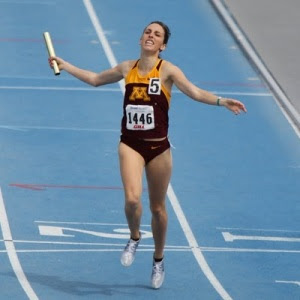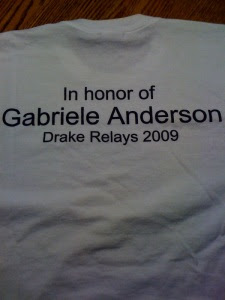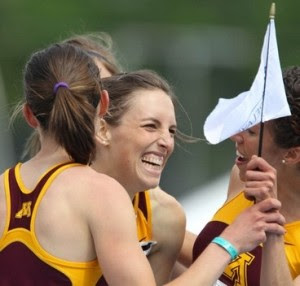Gabrielle Anderson – She is that tough!
Tags: www.gabrielegrunewald.com Adenoid Cystic Carcinoma
Gabrielle Anderson was a Minnesota state champion in the 800 meters and earned all-state honors four times in cross country while attending Perham High School. She earned scholarship to the University of Minnesota, and where she qualified for the NCAA Cross Country Championships three times, the NCAA Indoor Track & Field Championships two times, and earned All-Big Ten Conference honors five times.
Gabrielle, or “Gabe” as her friends call her, developed a reputation for having a tough look on her face at the end of races when it was time to dig deep and keep fighting despite the pain. This was dubbed “Gabe Face” by her Minnesota teammates.
The lump on the side of Gabriele Anderson’s neck was small, almost to the point of being unnoticeable.

Located right below her left ear, where her jawline ended, the lump was more a nuisance than anything worth worrying about.
Anderson was living in a basement in the spring of 2009, and she figured the lump was nothing more than an inflamed lymph node somehow related to her allergies.
Anderson never concerned herself with the abnormality that was painful to the touch but nothing, she figured at the time, to worry about.
She was 22.
Cancer wasn’t on her radar and it had never been an issue with her family. But, almost ironically, it would quickly creep into her life without warning.
She had chosen to skip an annual spring break trip, giving Anderson the chance to spend time with her family in Perham, Minn., a small town of less than 3,000 residents nestled three hours north of the Twin Cities.
During the 179-mile drive home from Minneapolis, Anderson’s phone rang. It was her father calling with alarming news.
Doctors had discovered a tumor on Gabriele’s mother, Laura Anderson’s ovary. They feared it was cancerous.
In the weeks that followed, Gabriele accompanied Laura to doctor’s appointments in Minneapolis. Laura underwent a battery of tests before having a complete hysterectomy done in an attempt to rid her body of the mass doctors had detected.
The tumor, doctors found, turned out not to be cancerous.
Relief overcame Gabriele, who figured the worst was over.
Turns out, it was just beginning.
There was the still the matter of the small lump on the side of Anderson’s neck. Having ignored it long enough, Anderson visited a ear, nose and throat specialist to have the growth investigated.

Anderson continued to insist nothing was seriously wrong.
She traveled with her teammates to Arizona State, where she’d make her debut in the 1,500-meter run. The day before her race, Anderson sat in a hotel lobby in Phoenix, when her cell phone again rang.
Again, there was news.
Her doctor informed her she had found Adenoid cystic carcinoma, a rare form of cancer on her parotid gland. She would have to undergo surgery in the next week and face radiation treatments soon after.
“Obviously, your head goes to very scary places when you first hear that,” Anderson says.
She immediately Googled the rare cancer and discovered doctors and researchers knew little about it. She phoned her mother before telling her coach and her teammates.
For Laura Anderson, who had only recently dealt with her own cancer scare, her daughter’s diagnosis was overwhelming.
During her mother’s ordeal, Gabriele had been the strong one; remaining optimistic everything would be OK. Now dealing with cancer first-hand, Anderson remained hopeful, mapping out what her treatment would involve and reserving judgment of what the future held.

The news hit Anderson’s mother hard.
“It’s just such a devastating prognosis,” says Laura Anderson, who still has difficulty discussing her daughter’s illness without becoming emotional. “It really took a toll and it really wiped her out.
“It was very upsetting.”
Telling people made the diagnosis feel real — even if it didn’t seem real to her at the time. She did her best to remain optimistic, but Anderson also understood the severity of her condition.
“You’re going into it, and you’re 22 years old and you’re thinking about getting married and having a family,” Anderson says. “Running becomes this small, little thing on the side.
“You’re always thinking of the next meet, the next race, the next year. ALSO When I got diagnosed with cancer, I was like, ‘There may not always be a next year. That was one of the first times in my life I had that thought and it was real to me.”
The next day, Anderson ran at Arizona State, finishing second.
She wondered when she’d run again.
Between the treatments and the serious neck dissection surgery that Anderson’s fiancé and training partner, Justin Grunewald, describes as “something I wouldn’t wish on anyone.”
She went through the normal phases and denial and shock before focusing her attention on her recovery.

The process was difficult and transformational, putting Anderson’s life and running career into perspective.
“It really makes you set your goals and you really don’t mess around with anything that’s not important to you,” Grunewald says. “Obviously, running was important to her.”
By August, she was running again, plotting a comeback that would require her to obtain a fifth year of eligibility from the NCAA.
She trained as much as her body allowed her to, traveling with Minnesota’s women’s cross country team. She assumed the role of assistant coach, using her teammates for support while slowly moving closer to returning to the track, a place that always had made her feel normal.
During the indoor season, Anderson won her first race back, claiming a 3,000-meter indoor event in Minneapolis. She then set a new personal best in the mile soon after at the Iowa State Classic, shattering her previous personal record in the event by four seconds.
“That’s when I knew maybe something special was going to happen,” Anderson says.
Anderson was granted another year of eligibility, allowing herself to finish out her collegiate running career on her terms. The 2012 Games weren’t on her radar, as she remained focus on spending time with her teammates, appreciating running perhaps like never before.
She savored every moment with her teammates before finishing as the runner-up at the NCAA championships in the 1,500.
Slowly, she began to set her sights higher.
Following the NCAA championships in June 2010, Anderson went to Europe and raced there, preparing for a professional running career. She signed on with Brooks, joined a post-collegiate running group with Team USA Minnesota, beginning on a road to establish herself as one of the nation’s top distance runners.
Doctors, meanwhile, had spotted something on one of Anderson’s scans that concerned them.

Again, she put it off, not thinking — like her doctors — that anything serious was happening with her health. Months after doctors had first spotted the abnormality, Anderson had a biopsy performed.
Cancer. Again.
“I think she was just in shock,” Laura Anderson says. “That just came from a place she didn’t even consider possible. I think the double-whammy just knocked the wind out of her.”
Doctors diagnosed Anderson with an aggressive thyroid cancer that was complexly unrelated to the cancer they had discovered in her neck 18 months before.
The news again left Anderson floored.
“I had thought, here I’ve come so far in the last year and a half — had gone through surgery — all the radiation therapy and returned to running and had such a great season,” Anderson says. “I felt completely blindsided. It felt like I was starting all over again.”
If there was a silver lining, it was that unlike her first diagnosis, Anderson’s long-term outlook was much less daunting. Her immediate future was much more familiar, giving Anderson hope that if she had overcome cancer once, she could certainly do it again.
Anderson had her thyroid removed and had an additional neck surgery. This past winter, she underwent radioactive iodine therapy to get rid of any remaining thyroid cancer.
She pressed forward with her training; running with a new attitude that those who train with her on a regular basis believe didn’t exist before she was diagnosed with cancer.

“She really sees her running as something special and an opportunity to really see what she said do,” says Team USA Minnesota coach Dennis Barker. “She doesn’t set any limits on herself — I think the cancer has taken some of those limits off.
“But I think she sees it as being special because it could have turned out a different way where she wouldn’t be there. The fact she is out there, I think she wants to take advantage of every minute she has out there.”
Like Barker, Laura Anderson sees and notices a difference in her daughter. Gabriele is more contemplative, taking little for granted …. while making the most of each new day and each opportunity. Laura marvels at how positive of an outlook Gabriele approaches life and her running with — appreciative of what she has and the journey that has brought her to London’s doorstep.
Gabe’s story about exceptional toughness begins in the spring of 2009. She was in the early weeks of what was supposed to be her fifth year (senior season) at Minnesota. She had noticed a small lump under her ear at the top of her jaw and in March doctors performed a fine needle aspiration to sample the tumor. After the test, Gabe flew with her teammates to Tempe, Arizona for the Sun Angel Invitational, where she was slated to run the 1500 meters.
On April 10, 2009, the day before the meet, she got a call from the doctor – she had adenoid cystic carcinoma, a rare form of cancer of the salivary gland. Her coach Gary Wilson gave her the option to pull out of the meet because of the shocking news. But Gabe decided to race. Not knowing what the future had in store, it very well could have been her last race. Under these incredibly stressful conditions she ran a PR of 4:22.87. Five days later she had surgery to remove the tumor.
The surgery and battle with cancer put an end to her season, and meant that she would miss the Drake Relays, one of the highlights of the season for Minnesota.
At previous Drake Relays Gabe had run on three winning relay squads, including 2007 when Minnesota set the meet record for the 4X800 meter relay. Gabe would not be at the 2009 Drake Relays, but her Minnesota teammates were thinking about her. They made “Gabe” patches to put on their uniforms. Also, her teammates made shirts to honor her toughness. The shirt had a picture of Gabe in one of her aforementioned “Gabe Face” moments, with the words, “Are you this tough?” above it.
Gabe would need to keep being tough. Even after the surgery, Gabe’s battle with cancer continued. Over the summer she underwent radiation treatment five times a week for six weeks. Adenoid cystic carcinoma has a high rate of late metastasis, which means that Gabe will need to get frequent checks for the rest of her life to see if the cancer has come back.
In August the twenty-three year old began running again, slowly at first, eventually building back to a higher level of training during the fall. She also decided to petition the NCAA for a medical hardship so she could compete for Minnesota in the spring of 2010 – it would be her fourth (senior) season but her sixth year in college. In December she got approval from the NCAA, she would be eligible to compete in the outdoor track & field season in 2010. Her collegiate career would not end with the 1500 PR earned under trying circumstances at the Sun Angel meet. She would get a full senior season to train hard, race fast, and be with her teammates.
On the one year anniversary of her diagnosis, she was back at Sun Angel running in the 1500. She PR’ed in 4:20.56! Then at the 2010 Drake Relays she anchored Minnesota to first place in the 4X800 meter relay and the 4X1600 meter relay. It was Minnesota’s fourth straight 4X800 meter relay win and they set the 4X1600 meter relay meet record.
The photos taken after the race suggest that if you have “Gabe Face” and are tough when you compete, you will be rewarded with a race that puts a big smile on both your and your teammates’ faces. http://www.supersoul.tv/minisessions/marie-forleo-the-belief-that-can-make-you-unstoppable
Preview YouTube video A rare cancer. Adenoid Cystic Carcinoma Awareness.

Preview YouTube video ACC- Signs I had leading up to a cancer diagnoses.







